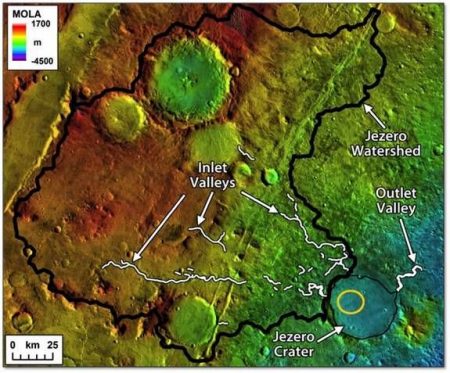November 21, 2018 – With the Martian rover Opportunity moribund and likely never to reawaken, Mars will have one active rover on its surface, Curiosity, until a companion with a similar form factor but a different package of experiments, arrives in 2020. Curiosity (the Mars Science Laboratory) landed at Gale Crater in August of 2012 with a two-year mission plan. Still going strong more than six years out, the robotic rover is powered by a plutonium-238-fuelled radioisotope thermoelectric generator providing 110 watts of electrical power and heating the fluids that keep the electronics and instrumentation at comfortable temperatures, as well as lubricating the robotic arm joints and wheels. Estimates by the Jet Propulsion Laboratory team of how much longer Curiosity will be viable vary from one more year to 10 or more years into the future.
The technology has more than proven itself and thus the Mars 2020 rover is largely a carbon copy. We are two years out from launch and finalized instrumentation includes some enhancements to Curiosity instrumentation as well as some new experiments. Here is a list of finalists that NASA recently published:
- Mastcam-Z is an advanced camera system that provides panoramic, stereoscopic and zoom capability. The Mastcam-Z will also be used to determine the mineralogy of the surface.
- SuperCam is another imaging instrument to do chemical composition, mineralogy analysis and detection of organic compounds in rocks and regolith from a distance.
- PIXL which is an acronym for Planetary Instrument for X-ray Lithochemistry. This x-ray fluorescence spectrometer contains a high-resolution imager to do detailed chemical and material composition of Martian surface materials.
- SHERLOC which is an acronym for Scanning Habitable Environments with Raman & Luminescence for Organics and Chemicals. A fine-scale imaging spectrometer which uses an ultraviolet laser to analyze mineralogy and detect organic compounds.
- MOXIE is the Mars Oxygen ISRU Experiment. This technology will attempt to harvest oxygen from the predominantly carbon dioxide atmosphere of Mars. It is a prototype for what future human missions to Mars will need to create a breathable atmosphere for long-term duration visits.
- MEDA is the Mars Environmental Dynamics Analyzer. This instrument includes sensors to measure temperatures, wind speed and direction, pressure, relative humidity, and dust particles.
- RIMFAX is the Radar Imager for Mars’ Subsurface Experiment. A ground-penetrating radar, RIMFAX will give scientists a centimeter-scale resolution of the subsurface geology of the planet.
Yesterday NASA and the European Space Agency (ESA) announced where the Mars 2020 will do its exploring. The site is Jezero Crater, a 50-kilometer-wide geological feature with some intriguing features. Satellite images reveal the crater bottom once featured a large lake fed by a stream that actually cut through the rim and formed a delta. It is believed that the existence of the stream and lake date back over 3.5 billion years ago when Mars was warmer and wetter. It is the existence of the delta that has scientists excited. States Ken Farley, NASA’s project scientist for Mars 2020, “A delta is extremely good at preserving bio-signatures – any evidence of life that might have existed in the lake water, or at the interface of the sediment and the lake water, or possibly things that lived in the headwaters region that were swept in by the river and deposited in the delta.”

The Mars 2020 will at some point be given a name that is less formal. Curiosity’s formal name, the Mars Science Laboratory or MSL, has little cachet with the public so it is likely the new rover will get its own memorable iconic name. I would love to see it named Discovery or Endeavor.
Let’s hope that NASA doesn’t hold a naming contest leading to something ridiculous such as Boaty McBoatface, the name given to a UK research vessel after a the science ministry in that country held an online public poll.
Mars 2020’s tentative launch will be from Earth in the July-August 2020 period with the landing scheduled for mid-February 2021. An interesting addition to this mission is the gathering and caching of rock samples to be stored until a future mission to Jezero can collect them for a return to Earth. That mission has yet to be announced and will likely not happen until the late 2020s or early 2030s.
Meanwhile, there is another mission to Mars about to rendezvous and land on the planet. InSight is an acronym for Interior Exploration using Seismic Investigations, Geodesy and Heat Transport. The lander today is five days away from touchdown. NASA is broadcasting the landing live. The landing site is Elysium Planitia, about 3 degrees north of the Martian equator. Not a rover, InSight has instrumentation designed to study the Martian interior. Included in its science package are:
- SEIS, a seismometer to record seismic waves to reveal the interior structure of the planet and determine the level of tectonic activity.
- RISE, two radio antennas to accurately track the lander’s location revealing the planet’s wobble.
- HP3, a probe investigating how much heat continues to be generated by the Martian interior.
And then there is ExoMars 2020, an ESA six-wheeled rover planned for a 2020 launch as well. ExoMars will be powered by solar energy and state-of-the-art batteries unlike Mars 2020 (using plutonium-238). Its Pasteur instrumentation package is designed to analyze the planet’s geochemistry as well as detect exobiology. ExoMars will feature autonomous navigation so that Earth-based scientists can designate target destinations and let the rover pick the safest route using onboard digitally-created maps from its stereo navigation and collision-avoidance cameras. ExoMars will feature an articulated assembly to allow each wheel to drive independently and lift the main body of the rover to adjust its height to deal with local terrain obstacles. It should make an admirable companion to Mars 2020, Curiosity, and the InSight lander, helping scientists to reveal more Martian secrets.








